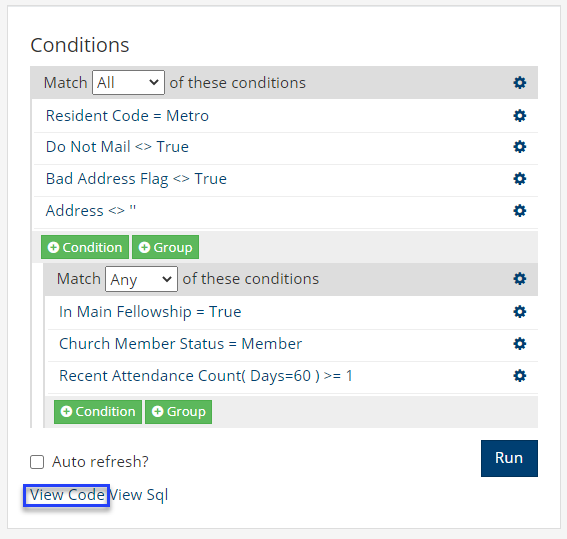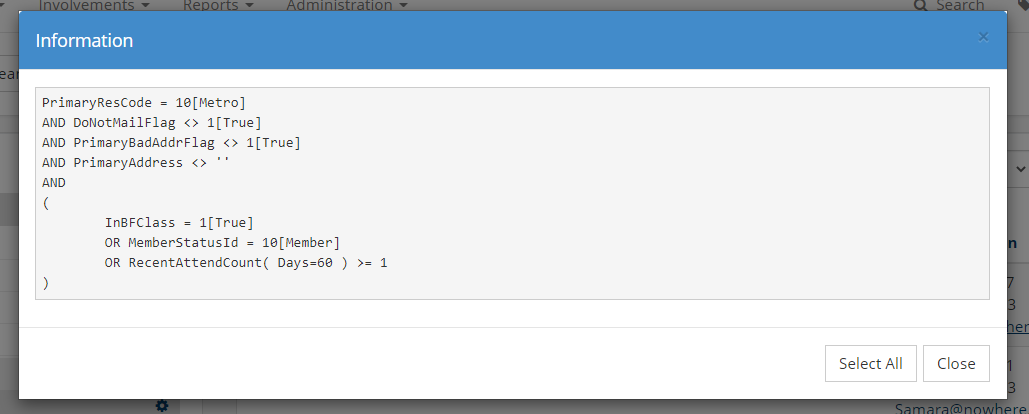How to Use Search Builder¶
Search Builder is the go-to tool when you want to build a target group to email, print labels or run reports for, or just to find out how many people match your criteria. You will use Search Builder to mine your TouchPoint database using conditions you specify.
Note
Each database created after May 16, 2017, will contain 5 sample searches. You can use those to get started building your own. If you do not see all of these searches when you go to Saved Searches, enter the word sample in the name field and press search. These are just a few ways to use Search Builder to find people based on the conditions they meet at the time you run the search.
Searches are built using a combinations of conditions. The conditions you use can be as simple as finding everyone with a Church Member Status of ‘Member’. Or they can be as complex as something like one the following:
Members, aged 30-40, who have children of a specified age range that have attended something in a specified number of days.
Everyone who attended a Worship Service as a New Guest during a specified date range and has not attended a Life Group.
The possibilities are endless…or at least close to it!
Results, Reports, Actions
Once you run your search, the results will be a page giving basic information about the individuals. The results page will always contain the same columns. Use the Blue Toolbar for any actions or reports you want for this group of individuals.
See also
Search Builder is also used to create Status Flags.
See also
Code Link¶
There are a couple of places you will see View Code or just Code in Search Builder. One is when you are viewing Saved Searches. It is beside the Description/Name of the saved search. The other place is on the search itself just below the list of Conditions.
Whether you click the link on the Saved Searches page or when viewing an individual search, that link will do the same thing. It will show you the code that is used to run the search.

Individual Search¶

Code for Individual Search¶
Notice in the code where you see OR. This is where you have selected Match Any above those Conditions. When you see AND, this is where you have selected Match All.
This link exists for 2 reasons:
To give you a view of your entire search without having to open up each individual Condition to do so. Even though it is code, it is a user-friendly way to examine your search.
To allow an Admin to copy this code to use in a Python script. Then the script does not have to reference a search, but can contain the code for the search inside the script. And the user will not have to type in the actual code; he will copy and paste it.
Create a New Search¶
- Step 1
In the header, click Search, and then select Search Builder > New Search
This will open the dialog with all the Conditions.
- Step 2
If you know a key word for the condition you want, type it where you see Filter. This will filter for conditions with that word. Click on the one your want to add to your search. Or, click the Categories tab and select one of the 16 Categories. Then select the Condition you want to add to the search.
See this 38-second video.
- Step 3
Once you add the Condition to your search, you will need to select a comparison and a code. Or you will need to enter some text. It depends on the Condition itself. For example: the Condition Church Member Status has an option for Comparison of Equal, for which you select a Code from the dropdown list. Or you select a Comparison of One Of and then select more than one Code from the list.
- Step 4
Click Save, and then Run to view the results with just that one Condition.
Note
If the box Auto Refresh is checked, your search will run automatically after each addition or change.
- Step 5
Continue in this fashion, adding whatever Conditions you need for your search.
See this 1-minute video.
Important
If you add multiple Conditions, make sure have the correct option for the top Condition- either Match All, Any, None, or Not All.
- Step 6
Save your search by selecting Save or Save As. For unsaved, draft search, these two will do the same thing. Enter the name of your search, making it fairly short, but descriptive of its purpose. If you want other users to be able to access your search check the box Make Public. Click Save.
Groups¶
Each search contains at least one Group and you can add more as needed. We have a thorough explanation for using groups in another help article.
See also
Convert to Search¶
There are a number of places in TouchPoint where you can select Convert to Search. This builds searches on-the-fly behind the scenes. For example, on a Meeting page under the Blue Toolbar > Gear, you can convert to search Attendees, Absentees or Guests by selecting the appropriate Convert to Search option. There are a number of other places where we have this feature, too.
See also
After clicking Convert to Search, your search will run and you can use the Blue Toolbar just like you would for a search that you created for yourself.
Take a look at some of the places you will find Convert to Search links.
Conditions:¶
There are 16 categories, each with multiple Condition options. The best way to learn is to just explore and click on each category to see the options. As demonstrated in the videos above, you will land on the All tab, where you have the option of entering a keyword to find a Condition; or you can select the Categories tab, select a category, and then select a Condition.
Tip
Each Condition in the dialog box will have a ?Help Article button to the right. Click that to view the individual help article about that Condition.
Here is a summary of the categories, with a description of the types of Conditions available:
- Personal
Age, gender, marital status, employer, occupation and Conditions relating to an individual
- Family
Position in family, number of family members, family has children, and other Conditions relating to the family
- Address
Resident code, zip, city, and Conditions relating to addresses
- Contact Info
Home #s, whether the spouse has an email address, texting, and other Conditions relating to contacting people
- Ministry
Conditions relating to Tasks, Contacts, items marked on a guest card
- Membership
Campus, member status, join date, decision type, and other items relating to a person’s church membership
Tip
Watch the video below for instructions on building a search to find church members based on the date they joined.
- Enrollments
Conditions relating to a person’s involvement, including items such as Member type within an organization, sub-group, number of enrollments
- Enrollment History
Conditions relating to enrollment dates to find historical data
- Current Org
Looks at those currently enrolled in the most recent organization you viewed, or is a prospect, previous member and more
- Volunteer
Volunteer status, whether they have a volunteer application, their approval code - items on a person’s Volunteer tab
- Recent Attendance
Conditions relating to attendance, allowing you to look back a number of days, a family’s children’s attendance and more
- Attendance Dates
Similar to above, but using date ranges
- Extra Values
Conditions relating to various types of extra values
- Contributions
Conditions relating to envelope options, statement options, recent contribution count and other items relating to contributions
Important
You must have the user role of Finance in order to see any results using these Conditions.
- Miscellaneous
Just what it sounds like - a potpourri of Conditions
- Admin
Items relating to user accounts, when and by whom records were created, Conditions used by the system admin
As you see, there are tons of options to use and combine to make effective searches. The list above just scratches the surface. You need to experiment with various combinations to see just how flexible and far-reaching this tool can be.
Videos of Sample Searches¶
Here are a few videos to serve as samples to help you get started. Be sure to check out our YouTube channel as well.
Finding Church Members Based on their Join Date
Creating a Search Using Multiple Groups of Conditions
Newsletter Search (Resident Adult Members)
Newsletter Search Expanded (Using Multiple Groups,Cut & Paste)
Latest Update |
11/13/2020 |
Modify image link with secure protocol.
